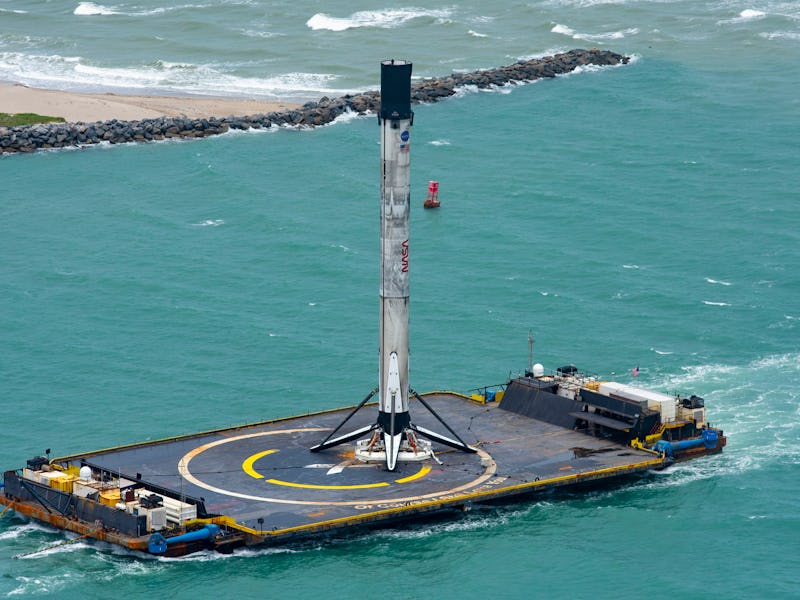SpaceX Crew Dragon: impressive images capture Falcon 9 landing and return
The rocket carrying the capsule successfully returned to Earth after its historic launch.

SpaceX's Falcon 9 has successfully made its way to terra firma. On Tuesday, the space-faring firm shared images of its rocket perched on a droneship, arriving in at Port Canaveral after its successful mission last week.
"After launching [astronauts Bob Behnken] and [Doug Hurley] to orbit on Crew Dragon, Falcon 9 landed on the Of Course I Still Love You droneship and returned to Port Canaveral," the company posted on Twitter.
Rocket landings are practically routine for the firm at this stage, but this one is different for two reasons. The first is that the rocket was the first Falcon 9 responsible for sending humans into space. On Saturday, May 30 at 3:22 p.m. Eastern time, the rocket took off from the Kennedy Space Center Launch Complex 39A in Florida. Attached to the rocket was the Crew Dragon capsule, with NASA astronauts Bob Behnken and Doug Hurley inside.
The capsule returns to the port.
The second, as spotted by Twitter user "SpaceXFleet," is that it's the first time SpaceX has operated two droneships in the same ocean at the same time. These ships are used as a landing platform for Falcon 9 rockets as they return to Earth. As Of Course I Still Love You was making its way from the Atlantic Ocean to Port Canaveral, Just Read the Instructions was making its way to the landing zone for SpaceX's next mission. The firm is scheduled to use the latter ship on Wednesday for its next Starlink launch, sending up another 60 satellites for its internet connectivity constellation.
A larger view of the rocket coming through.
Thee landings have become somewhat commonplace, a testament to SpaceX's work to improve this area. It first tried, and failed, to land a booster in 2013. It first succeeded in 2014. In 2017 and 2019 it landed its highest number of boosters in a year, with 15 each year. To put that in perspective, SpaceX launched 13 rockets in 2019, two of which were the triple-core Falcon Heavy, meaning it recovered almost all the boosters that year. It has landed 52 boosters in total.
Coming in to land.
These impressive figures put SpaceX on the path to reducing the cost of rocket launches. Each Falcon 9 mission has a publicized price tag of $62 million. Saving the booster recuperates around $46.5 million of that. This advancement means the firm can put more funding toward its more ambitious projects.
A successful landing.
Some of these bolder plans are already starting to take shape. The Starship, a vehicle currently under development at a facility in Texas, is a fully-reusable rocket designed to send up over 150 tons or 100 people into space at a time. Its reusability means launches could, according to Musk in November 2019, cost just $2 million per launch.
The ship will have the ability to take over satellite launches currently covered by Falcon 9, as well as more ambitious missions like a city on Mars. This could mean that future rocket landings will see giant, stainless steel ships returning to spaceports located in the ocean.
The Inverse analysis – With the NASA Commercial Crew program, these landings could become a commonplace feature for trips to the International Space Station. The program was aimed at plugging the gap in service left by the end of the shuttle program, which finished in 2011. NASA was using Soyuz rockets taking off from Baikonur Cosmodrome in Kazakhstan to send up astronauts, but the successful launch of the Crew Dragon may signal future launches will take place a little closer to home.
It may not be the first time SpaceX has to send out two droneships to the same ocean. Could A Shortfall of Gravitas, a previously-announced third droneship, join them eventally?